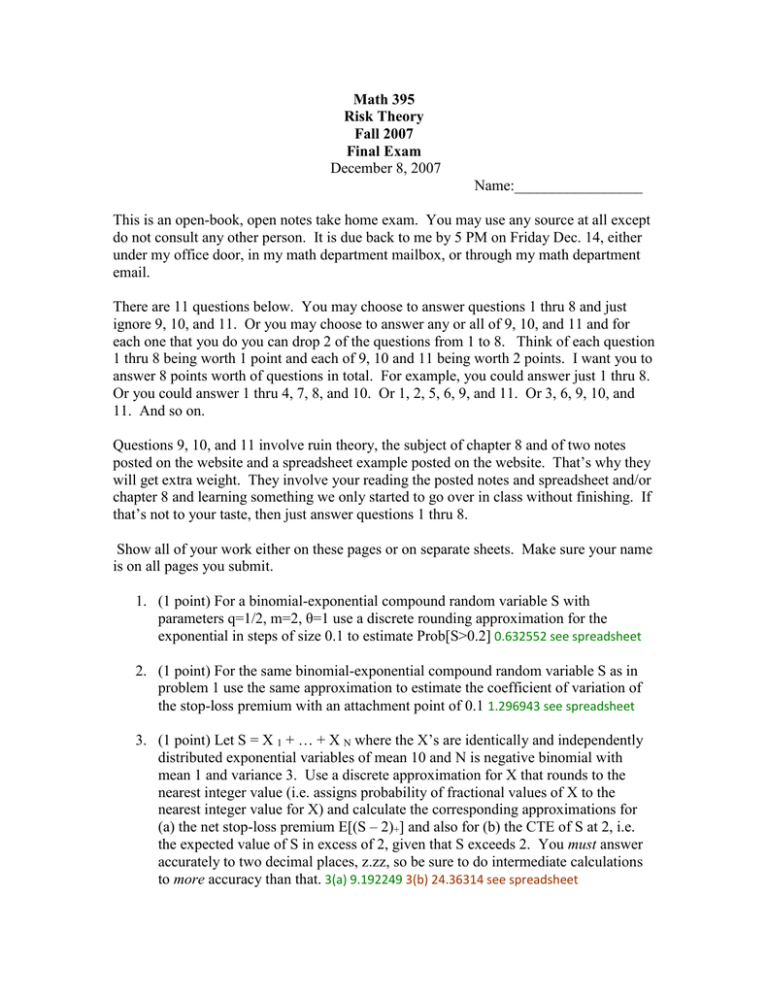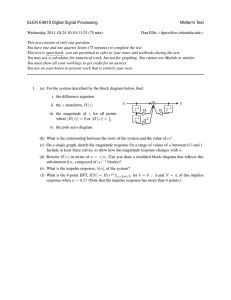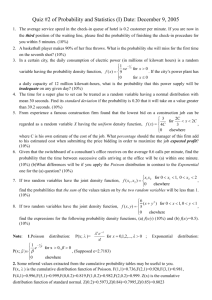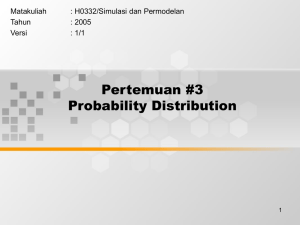Math 395 Risk Theory Fall 2007 Final Exam
advertisement

Math 395
Risk Theory
Fall 2007
Final Exam
December 8, 2007
Name:_________________
This is an open-book, open notes take home exam. You may use any source at all except
do not consult any other person. It is due back to me by 5 PM on Friday Dec. 14, either
under my office door, in my math department mailbox, or through my math department
email.
There are 11 questions below. You may choose to answer questions 1 thru 8 and just
ignore 9, 10, and 11. Or you may choose to answer any or all of 9, 10, and 11 and for
each one that you do you can drop 2 of the questions from 1 to 8. Think of each question
1 thru 8 being worth 1 point and each of 9, 10 and 11 being worth 2 points. I want you to
answer 8 points worth of questions in total. For example, you could answer just 1 thru 8.
Or you could answer 1 thru 4, 7, 8, and 10. Or 1, 2, 5, 6, 9, and 11. Or 3, 6, 9, 10, and
11. And so on.
Questions 9, 10, and 11 involve ruin theory, the subject of chapter 8 and of two notes
posted on the website and a spreadsheet example posted on the website. That’s why they
will get extra weight. They involve your reading the posted notes and spreadsheet and/or
chapter 8 and learning something we only started to go over in class without finishing. If
that’s not to your taste, then just answer questions 1 thru 8.
Show all of your work either on these pages or on separate sheets. Make sure your name
is on all pages you submit.
1. (1 point) For a binomial-exponential compound random variable S with
parameters q=1/2, m=2, θ=1 use a discrete rounding approximation for the
exponential in steps of size 0.1 to estimate Prob[S>0.2] 0.632552 see spreadsheet
2. (1 point) For the same binomial-exponential compound random variable S as in
problem 1 use the same approximation to estimate the coefficient of variation of
the stop-loss premium with an attachment point of 0.1 1.296943 see spreadsheet
3. (1 point) Let S = X 1 + … + X N where the X’s are identically and independently
distributed exponential variables of mean 10 and N is negative binomial with
mean 1 and variance 3. Use a discrete approximation for X that rounds to the
nearest integer value (i.e. assigns probability of fractional values of X to the
nearest integer value for X) and calculate the corresponding approximations for
(a) the net stop-loss premium E[(S – 2)+] and also for (b) the CTE of S at 2, i.e.
the expected value of S in excess of 2, given that S exceeds 2. You must answer
accurately to two decimal places, z.zz, so be sure to do intermediate calculations
to more accuracy than that. 3(a) 9.192249 3(b) 24.36314 see spreadsheet
Name:___SOLUTIONS___
4. (1 point) Derive the coeficient of skewness for each of the following distributions:
negative binomial, binomial, Poisson. (You may start by assuming that you know
any probability generating functions that you need but do not assume that any
other generating functions or moments are known without deriving them, possibly
from probability generating functions or by any other means.)
Prob gen function for (a,b,0) is P(z)=[(1-az)/(1-a)]^(-(b/a+1)) so
C(z)=-(b/a+1)[ln(1-ae^z)-ln(1-a)]
Taking derivatives, σ2 =(b/a+1)(a/(1-a))(1+a/(1-a))
μ3=(b/a+1)(a/(1-a))(1+a/(1-a))(1+2a/(1-a))
So μ3/ σ3=binom (1-2q)/(mq(1-q))^.5, poisson 1/λ^.5, neg.binom (1+2β)/(rβ(1+β))^.5
5. (1 point) A certain claim frequency variable is known to follow a Poisson
distribution for any given insured person, but the Poisson frequency λ varies
among the insured population. In fact, λ is distributed across the population as the
sum of 5 identically and independently distributed exponential variables, each
with mean 0.04. A deductible is introduced into the coverage that has the effect
of eliminating 20% of all claims across the board without affecting any other
aspect of the claim distribution or of the insured population. (a) What are the
mean, variance and third central moment of the resulting frequency of claim
payments? (b) What would be the mean, variance and third central moment of the
resulting frequency of claim payment (again, after the effect of the deductible) if
the original λ were fixed at a value equal to the mean of the distribution of λ,
instead of varying across the population?
(a) λ is gamma(5,.04) so the mixture is neg.bin.β=.04,r=5. Eliminating 20% of the claims
makes it a neg. bin. with .8β.
Mean=r(.8β)=.16,Variance=r(.8β)(1+.8β)=.16512,μ3=r(.8β)(1+.8β)(1+1.6β)=.175688
(b) They would all be .8λ=.8(rβ)=.16
6. (1 point) Show that the following four distributions are of the same form (i.e. they
represent the same form of distribution) but possibly with different parameters:
geometric-geometric; Bernoulli-geometric; zero-truncated geometric; zeromodified geometric. (Bernoulli is binomial for a single trial)
Referring to App. A for the PGFs,
PGG(z)=PG(PG(z))={1-β1[(1-β2(z-1))-1-1]}-1=[1- β2(z-1)]/[1-β2(1+β1)(z-1)], similarly
PBG(z)=[1-β(1-q)(z-1)]/[1-β(z-1)] & PZTG=[1-(-β)(z-1)]/[1-β(z-1)] and finally
PZMG(z)=p0+(1-p0)PZTG(z)=[1-(2p0-1)β(z-1)]/[1-β(z-1)] so all four have the form
P(z)=[1-k1(z-1)]/[1-k2(z-1)]
7. (1 point) Individual loss amounts (ground up) this year follow a two parameter
Pareto distribution with α = 3 and expected value 1000. Next year you
confidently expect loss amounts to inflate by 10% uniformly across the board.
What will be the standard deviation next year for loss amounts that are limited to
2,000 per loss with the limited loss amount further subjected to a 200 deductible
per loss? Please answer for the “per loss” variable, not the “per payment”
variable. 653.76 see spreadsheet
8. (1 point) Suppose Y has a Pareto distribution with parameters α and θ. Let
X=ln(1+Y/ θ). What are the name and parameters of the distribution of X? Be
sure to include reasons for your answer.
Exponential with parameter α because
prob[X<x]=prob[ln(1+Y/θ) <x]=prob[Y<θ(e^x-1)]=1-[θ/(θ+θ(e^x-1))]^α since Y
Pareto, but this simplifies to the exponential with parameter α.
Name:_SOLUTIONS______
9. (2 points) In the compound model S(t) = X1 + … + XN(t) for a continuous
aggregate claim process, leading to the surplus process u(t)=u+ct-S(t), explain
why the assumption that N(t) is a Poisson process, i.e. a Poisson λt distribution
for each t, is essential if we want to conclude easily that the density fL1(y) for the
random variable L1, the size of the first drop below the starting surplus of u, is
given by the equilibrium distribution fL1(y) = SX(y)/E[X]. (You don’t need to
prove anything rigorously to answer this question, but you do need to be very
specific about exactly where in the logic of the proof in the ruin theory notes
posted on the website the Poisson assumption sets up the breakthrough that leads
to the conclusion.)
On page 8 of the Ruin Theory I notes it’s crucial to have the memoryless property in
order to have the upside-down and backward process from U(T+H) to U(T) be
identical to the process from U(0) to U(T). Only the exponential has the memoryless
property, and only the Poisson process has exponential waiting times between events.
So without the Poisson assumption the waiting times between events would not be
exponential, there would be no memoryless property in the waiting times, and the
process from U(T+H) to U(T) would not match the one from U(0) to U(T). Then L1
would not have the same distribution as U(T¯) and it would be impossible to prove at
the top of page 8 that L1 follows the equilibrium distribution of X.
10. (2 points) In the same model for u(t) just described, let N(t) be a Poisson process
with λ=0.25, let X be a Pareto (3,1), and let the safety margin involved in the
determination of c be θ=0.1. Let L be the maximum aggregate loss random
variable defined by L=L1 + …. + LK , where these are K iid copies of L1, where K
is a geometric random variable with a = 1/(1+θ) in the (a,b,0) notation. Get an
approximate numerical value for E[ L I L>0.2] . Most of the numbers you need to
start with are on the ruin probabilities spreadsheet posted on the website. (This is
the CTE for the 86%-ile of ruin probability … you’ll find the 86% on the
spreadsheet). 11.58544 see spreadsheet
11. (2 points) Write formulas for the first four central moments of the random
variable L1 (as defined in chapter 8 and in the ruin theory notes posted on the
website) in terms of the raw moments of the individual loss random variable X.
fL1=fX/SX i.e. the equilibrium distribution so μ=p2/(2p1), μ2=μ2'-μ2=p3/(3p1)-(p2/(2p1))2
and by similar work, only more algebra, μ3=p4/(4p1)-p3p2/(2p12)+2(p2/(2p1))3
and μ4=p5/(5p1)-p4p2/(2p12)+2(p3/p1)(p2/(2p1))2-3(p2/(2p1))4




